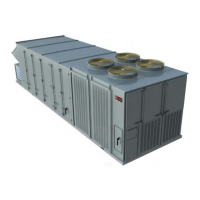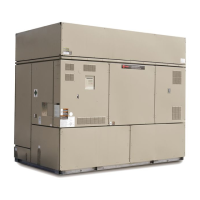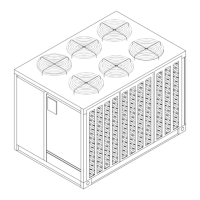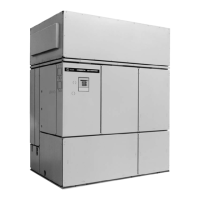RT-SVX24Q-EN
103
Electric Heat Sequence of Operation
The control system for the rooftop units are wired to
ensure that heating and cooling do not occur
simultaneously. Refer to electric heat wiring diagrams
that shipped with the unit while reviewing the
following sequence of operation. As you review the
sequence of operations, remember these points:
• The high limit switch will trip if exposed to a
temperature greater than the trip point, and will
reset automatically once the temperature falls
below the reset point.
• The linear high limit switch is encased in a capillary
that extends across the unit supply air opening. The
limit will trip if any 6” span of the capillary exceeds
the trip point. Refer toTable 68, p. 190.
• The manual limit switch will trip if exposed to a
temperature greater than the trip point, and will
need to be reset manually.
• Electric heat will only energize if all three of the
high limit safety controls are closed.
Electric Heat—CV, VAV Daytime Warm-up
CV electric heat operation is done with discrete stages
of electric heat. Stages 2 and 3 will not energize unless
Stage 1 is already operating and unable to satisfy the
heating load. The heat will be staged to control to the
Heating Setpoint.
VAV Active Occupied Discharge Heating
When the changeover input is closed (or when
commanded by BAS) the unit will control discrete
stages of electric heat to the active supply air heating
setpoint. VAV occupied electric heating operation is
done with discrete stages (steps) of electric heat. The
heat staging is dependent on unit tonnage and heater
selection. The heat will be staged to control to the
Supply Air Heating Setpoint.
SZVAV Occupied Heating
Single Zone VAV heating will only be available with
modulating types of heat - IPak II units can use
hydronic and modulating gas and will include electric
heat. During SZVAV heating, the unit will calculate a
discharge heating setpoint based on zone heating
demands, and the unit will modulate heat to maintain
the discharge temperature to this setpoint.
Demand Control Ventilation Sequence of
Operation
NNoottee:: CO
2
sensor used with Demand Control
Ventilation must be powered from an external
power source or separate 24 VAC transformer.
Sequence of Operation without Traq™
If the space CO
2
level is greater than or equal to the
Design Minimum CO
2
Setpoint, the outdoor air damper
will open to the Design Minimum Outdoor Air Damper
Setpoint. If there is a call for economizer cooling, the
damper may be opened further to satisfy the cooling
request.
If the space CO
2
level is less than or equal to the DCV
Minimum CO
2
Setpoint, the outdoor air damper will
close to the DCV Minimum Outdoor Air Damper
Setpoint. If there is a call for economizer cooling, the
damper may be opened further to satisfy the cooling
request.
If the space CO
2
level is greater than the DCV Minimum
CO
2
Setpoint and less than the Design Minimum CO
2
Setpoint, the outdoor air damper position is modulated
proportionally to the space CO
2
level relative to a target
position between the DCV Minimum CO
2
Setpoint and
the Design Minimum CO
2
Setpoint. If there is a call for
economizer cooling, the damper may be opened
further to satisfy the cooling request.
Sequence of Operation with Traq™
If the space CO
2
level is greater than or equal to the
Design Minimum CO
2
Setpoint, the outdoor air damper
will open to the Design Minimum Outdoor Air Flow
Setpoint. If there is a call for economizer cooling, the
damper may be opened further to satisfy the cooling
request.
If the space CO
2
level is less than or equal to the DCV
Minimum CO
2
Setpoint, the outdoor air damper will
close to the DCV Minimum Outdoor Air Flow Setpoint.
If there is a call for economizer cooling, the damper
may be opened further to satisfy the cooling request.
If the space CO
2
level is greater than the DCV Minimum
CO
2
Setpoint and less than the Design Minimum CO
2
Setpoint, the outdoor air damper position is modulated
proportionally to the space CO
2
level relative to a target
position between the DCV Minimum CO
2
Setpoint and
the Design Minimum CO
2
Setpoint. If there is a call for
economizer cooling, the damper may be opened
further to satisfy the cooling request.
Return Fan Sequence of Operation
Whenever the Supply Fan is turned ON, the return fan
will be turned ON. The speed of the return fan will
control to the Return Air Plenum Pressure Target. The
target is calculated internal to the control and will be
between the Minimum Return Air Plenum Pressure
Setpoint and the Maximum Return Air Plenum
Pressure Setpoint depending on unit operation
conditions. A Return Air Pressure High Limit will be set
at 3.5 IWC. If the pressure inside the return plenum
exceeds the limit the unit will shut down.
Unit Clustering
A cluster is a master unit and one or more similarly
configured slave units operative cooperatively, as a
group, to provide higher capacity and/or redundancy at
partial capacity. Clustering is accomplished by binding
variables between unit LCI-I modules, communicating
common setpoints and allowing each unit to run
UUnniitt SSttaarrttuupp
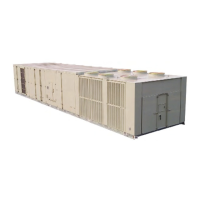
